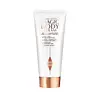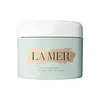What's inside
What's inside
 Key Ingredients
Key Ingredients

 Benefits
Benefits

 Concerns
Concerns

 Ingredients Side-by-side
Ingredients Side-by-side

Water
Skin ConditioningGlycerin
HumectantCaprylic/Capric Triglyceride
MaskingGlyceryl Stearate Se
EmulsifyingTricaprylin
MaskingCoco-Caprylate/Caprate
EmollientSoybean Glycerides
EmollientCetyl Alcohol
EmollientButyrospermum Parkii Butter Unsaponifiables
Skin Conditioning1,2-Hexanediol
Skin ConditioningPentylene Glycol
Skin ConditioningMyristyl Myristate
EmollientPotassium Cetyl Phosphate
EmulsifyingCaprylyl Glycol
EmollientCarbomer
Emulsion StabilisingAcrylates/C10-30 Alkyl Acrylate Crosspolymer
Emulsion StabilisingCamellia Oleifera Seed Oil
Skin ConditioningRosa Canina Fruit Oil
EmollientSodium Gluconate
Skin ConditioningSodium Hydroxide
BufferingCaffeine
Skin ConditioningHelianthus Annuus Seed Oil
EmollientHaematococcus Pluvialis Extract
AntioxidantMaltodextrin
AbsorbentTocopherol
AntioxidantRosa Damascena Extract
MaskingSodium Hyaluronate
HumectantAscorbyl Palmitate
AntioxidantRosa Damascena Flower Oil
MaskingRosa Damascena Flower Water
MaskingMichelia Alba Leaf Oil
MaskingAloe Barbadensis Leaf Juice
Skin ConditioningPlumeria Rubra Flower Extract
Skin ConditioningCitric Acid
BufferingPotassium Sorbate
PreservativeSodium Benzoate
MaskingLinalool
PerfumingCitronellol
PerfumingGeraniol
PerfumingWater, Glycerin, Caprylic/Capric Triglyceride, Glyceryl Stearate Se, Tricaprylin, Coco-Caprylate/Caprate, Soybean Glycerides, Cetyl Alcohol, Butyrospermum Parkii Butter Unsaponifiables, 1,2-Hexanediol, Pentylene Glycol, Myristyl Myristate, Potassium Cetyl Phosphate, Caprylyl Glycol, Carbomer, Acrylates/C10-30 Alkyl Acrylate Crosspolymer, Camellia Oleifera Seed Oil, Rosa Canina Fruit Oil, Sodium Gluconate, Sodium Hydroxide, Caffeine, Helianthus Annuus Seed Oil, Haematococcus Pluvialis Extract, Maltodextrin, Tocopherol, Rosa Damascena Extract, Sodium Hyaluronate, Ascorbyl Palmitate, Rosa Damascena Flower Oil, Rosa Damascena Flower Water, Michelia Alba Leaf Oil, Aloe Barbadensis Leaf Juice, Plumeria Rubra Flower Extract, Citric Acid, Potassium Sorbate, Sodium Benzoate, Linalool, Citronellol, Geraniol
Water
Skin ConditioningButylene Glycol
HumectantJojoba Esters
EmollientButyrospermum Parkii Butter
Skin ConditioningC12-20 Acid PEG-8 Ester
EmulsifyingGlycerin
HumectantPentaerythrityl Tetraethylhexanoate
EmollientCaprylic/Capric Triglyceride
MaskingSimmondsia Chinensis Seed Oil
EmollientPetrolatum
EmollientBehenyl Alcohol
EmollientCetyl Alcohol
EmollientSucrose
HumectantAlgae Extract
EmollientSesamum Indicum Seed Oil
EmollientMedicago Sativa Seed Powder
Skin ConditioningHelianthus Annuus Seedcake
AbrasivePrunus Amygdalus Dulcis Seed Meal
AbrasiveEucalyptus Globulus Leaf Oil
PerfumingSodium Gluconate
Skin ConditioningCopper Gluconate
Skin ConditioningCalcium Gluconate
HumectantMagnesium Gluconate
Skin ConditioningZinc Gluconate
Skin ConditioningTocopheryl Succinate
AntioxidantNiacin
SmoothingSesamum Indicum Seed Powder
Skin ConditioningYeast Extract
Skin ConditioningBupleurum Falcatum Root Extract
Skin ConditioningCucumis Sativus Fruit Extract
EmollientSigesbeckia Orientalis Extract
Skin ConditioningPhaeodactylum Tricornutum Extract
HumectantCucumis Melo Fruit Extract
Skin ConditioningAhnfeltia Concinna Extract
Skin ConditioningPolyglyceryl-2 Triisostearate
EmulsifyingMorus Nigra Root Extract
Skin ConditioningHordeum Vulgare Extract
EmollientAvena Sativa Kernel Extract
AbrasiveVitis Vinifera Fruit Extract
Skin ConditioningSilybum Marianum Extract
Skin ConditioningAcetyl Glucosamine
Skin ConditioningPersea Gratissima Oil
Skin ConditioningSodium Hyaluronate
HumectantCaffeine
Skin ConditioningBifida Ferment Lysate
Skin ConditioningAstrocaryum Murumuru Seed Butter
EmollientDimethicone
EmollientAcetyl Hexapeptide-8
HumectantGlyceryl Stearate
EmollientAcetyl Carnitine Hcl
Skin ConditioningSodium Rna
Skin ConditioningCreatine
Skin ConditioningPotassium Cetyl Phosphate
EmulsifyingSaccharomyces Lysate Extract
HumectantPropylene Glycol Dicaprate
EmollientCoenzyme A
Skin ConditioningPEG-100 Stearate
Decarboxy Carnosine Hcl
Skin ConditioningPEG-8
HumectantSodium Hydroxide
BufferingPhospholipids
Skin ConditioningAcrylates/C10-30 Alkyl Acrylate Crosspolymer
Emulsion StabilisingTetrahexyldecyl Ascorbate
AntioxidantHydrogenated Lecithin
EmulsifyingPropylene Glycol Dicaprylate
EmollientScutellaria Baicalensis Root Extract
AstringentSorbitol
HumectantSimethicone
EmollientLaminaria Ochroleuca Extract
Skin ConditioningCholesterol
EmollientCaprylyl Glycol
EmollientPotassium Sulfate
Disodium Cocoamphodiacetate
CleansingXanthan Gum
EmulsifyingParfum
MaskingLimonene
PerfumingHexyl Cinnamal
PerfumingGeraniol
PerfumingCitral
PerfumingLinalool
PerfumingBenzyl Benzoate
AntimicrobialAmyl Cinnamal
PerfumingCoumarin
PerfumingCitronellol
PerfumingDisodium EDTA
Sodium Benzoate
MaskingPhenoxyethanol
PreservativeWater, Butylene Glycol, Jojoba Esters, Butyrospermum Parkii Butter, C12-20 Acid PEG-8 Ester, Glycerin, Pentaerythrityl Tetraethylhexanoate, Caprylic/Capric Triglyceride, Simmondsia Chinensis Seed Oil, Petrolatum, Behenyl Alcohol, Cetyl Alcohol, Sucrose, Algae Extract, Sesamum Indicum Seed Oil, Medicago Sativa Seed Powder, Helianthus Annuus Seedcake, Prunus Amygdalus Dulcis Seed Meal, Eucalyptus Globulus Leaf Oil, Sodium Gluconate, Copper Gluconate, Calcium Gluconate, Magnesium Gluconate, Zinc Gluconate, Tocopheryl Succinate, Niacin, Sesamum Indicum Seed Powder, Yeast Extract, Bupleurum Falcatum Root Extract, Cucumis Sativus Fruit Extract, Sigesbeckia Orientalis Extract, Phaeodactylum Tricornutum Extract, Cucumis Melo Fruit Extract, Ahnfeltia Concinna Extract, Polyglyceryl-2 Triisostearate, Morus Nigra Root Extract, Hordeum Vulgare Extract, Avena Sativa Kernel Extract, Vitis Vinifera Fruit Extract, Silybum Marianum Extract, Acetyl Glucosamine, Persea Gratissima Oil, Sodium Hyaluronate, Caffeine, Bifida Ferment Lysate, Astrocaryum Murumuru Seed Butter, Dimethicone, Acetyl Hexapeptide-8, Glyceryl Stearate, Acetyl Carnitine Hcl, Sodium Rna, Creatine, Potassium Cetyl Phosphate, Saccharomyces Lysate Extract, Propylene Glycol Dicaprate, Coenzyme A, PEG-100 Stearate, Decarboxy Carnosine Hcl, PEG-8, Sodium Hydroxide, Phospholipids, Acrylates/C10-30 Alkyl Acrylate Crosspolymer, Tetrahexyldecyl Ascorbate, Hydrogenated Lecithin, Propylene Glycol Dicaprylate, Scutellaria Baicalensis Root Extract, Sorbitol, Simethicone, Laminaria Ochroleuca Extract, Cholesterol, Caprylyl Glycol, Potassium Sulfate, Disodium Cocoamphodiacetate, Xanthan Gum, Parfum, Limonene, Hexyl Cinnamal, Geraniol, Citral, Linalool, Benzyl Benzoate, Amyl Cinnamal, Coumarin, Citronellol, Disodium EDTA, Sodium Benzoate, Phenoxyethanol
Ingredients Explained
These ingredients are found in both products.
Ingredients higher up in an ingredient list are typically present in a larger amount.
Acrylates/C10-30 Alkyl Acrylate Crosspolymer is a synthetic polymer. It is used to thicken and improve the texture of products. Due to its properties, it can prevent water and oil ingredients from separating.
Caffeine is most associated with coffee, tea, and cacao. In skincare, it helps with calming inflammation and is rich in antioxidants.
While caffeine is used to treat cellulite and and dark circles, further studies are needed to prove this. It has been believed to help with these skin conditions due to its ability to dilate blood vessels and increase blood flow.
Some studies are looking into caffeine's ability to protect against UV rays.
Learn more about CaffeineThis ingredient is an emollient, solvent, and texture enhancer. It is considered a skin-softener by helping the skin prevent moisture loss.
It helps thicken a product's formula and makes it easier to spread by dissolving clumping compounds.
Caprylic Triglyceride is made by combining glycerin with coconut oil, forming a clear liquid.
While there is an assumption Caprylic Triglyceride can clog pores due to it being derived from coconut oil, there is no research supporting this.
Learn more about Caprylic/Capric TriglycerideCaprylyl Glycol is a humectant and emollient, meaning it attracts and preserves moisture.
It is a common ingredient in many products, especially those designed to hydrate skin. The primary benefits are retaining moisture, skin softening, and promoting a healthy skin barrier.
Though Caprylyl Glycol is an alcohol derived from fatty acids, it is not the kind that can dry out skin.
This ingredient is also used as a preservative to extend the life of products. It has slight antimicrobial properties.
Learn more about Caprylyl GlycolCetyl Alcohol is a fatty alcohol. Fatty Alcohols are most often used as an emollient or to thicken a product.
Its main roles are:
Though it has "alcohol" in the name, it is not related to denatured alcohol or ethyl alcohol.
The FDA allows products labeled "alcohol-free" to have fatty alcohols.
Learn more about Cetyl AlcoholCitronellol is used to add fragrance/parfum to a product. It is often derived from plants such as roses. In fact, it can be found in many essential oils including geranium, lavender, neroli, and more. The scent of Citronellol is often described as "fresh, grassy, and citrus-like".
Since the Citronellol molecule is already unstable, Citronellol becomes irritating on the skin when exposed to air.
Citronellol is a modified terpene. Terpenes are unsaturated hydrocarbons found in plants. They make up the primary part of essential oils.
Citronellol is not able to be absorbed into deeper layers of the skin. It has low permeability,
Citronellol is also a natural insect repellent.
Learn more about CitronellolGeraniol is used to add fragrance/parfum to a product. It is the main component of citronellol. It is a monoterpenoid and an alcohol.
Monoterpenes are naturally found in many parts of different plants.
Geraniol can be found in many essential oils including Rose Oil and Citronella Oil. The scent of Geraniol is often described as "rose-like". Many foods also contain Geraniol for fruit flavoring.
Geraniol can irritate the skin when exposed to air. However, irritation depends on the ability of geraniol to penetrate into the skin. In general, geraniol is not able to penetrate skin easily.
Geraniol is colorless and has low water-solubility. However, it is soluble in common organic solvents.
Like citronellol, it is a natural insect repellent.
2,6-Octadien-1-ol, 3,7-dimethyl-, (2E)-
Learn more about GeraniolGlycerin is already naturally found in your skin. It helps moisturize and protect your skin.
A study from 2016 found glycerin to be more effective as a humectant than AHAs and hyaluronic acid.
As a humectant, it helps the skin stay hydrated by pulling moisture to your skin. The low molecular weight of glycerin allows it to pull moisture into the deeper layers of your skin.
Hydrated skin improves your skin barrier; Your skin barrier helps protect against irritants and bacteria.
Glycerin has also been found to have antimicrobial and antiviral properties. Due to these properties, glycerin is often used in wound and burn treatments.
In cosmetics, glycerin is usually derived from plants such as soybean or palm. However, it can also be sourced from animals, such as tallow or animal fat.
This ingredient is organic, colorless, odorless, and non-toxic.
Glycerin is the name for this ingredient in American English. British English uses Glycerol/Glycerine.
Learn more about GlycerinLinalool is a fragrance and helps add scent to products. It's derived from common plants such as cinnamon, mint, citrus, and lavender.
Like Limonene, this ingredient oxidizes when exposed to air. Oxidized linalool can cause allergies and skin sensitivity.
This ingredient has a scent that is floral, spicy tropical, and citrus-like.
Learn more about LinaloolPotassium Cetyl Phosphate is the potassium salt of a mixture. This mixture consists of the esters from phosphoricacid and cetyl alcohol.
Potassium Cetyl Phosphate is an emulsifier and cleansing agent. Emulsifiers help stabilize a product. It does this by preventing certain ingredients from separating.
As a cleansing agent, Potassium Cetyl Phosphate helps gather oils, dirts, and pollutants from your skin. This makes it easier to rinse them away with water.
Learn more about Potassium Cetyl PhosphateSodium Benzoate is a preservative. It's used in both cosmetic and food products to inhibit the growth of mold and bacteria. It is typically produced synthetically.
Both the US FDA and EU Health Committee have approved the use of sodium benzoate. In the US, levels of 0.1% (of the total product) are allowed.
Sodium benzoate works as a preservative by inhibiting the growth of bacteria inside of cells. It prevents the cell from fermenting a type of sugar using an enzyme called phosphofructokinase.
It is the salt of benzoic acid. Foods containing sodium benzoate include soda, salad dressings, condiments, fruit juices, wines, and snack foods.
Studies for using ascorbic acid and sodium benzoate in cosmetics are lacking, especially in skincare routines with multiple steps.
We always recommend speaking with a professional, such as a dermatologist, if you have any concerns.
Learn more about Sodium BenzoateThis is the synthetic salt of gluconic acid, a form of PHA and mild exfoliant.
It is mainly used to stabilize oil and butter formulations from going bad. Sodium gluconate is a humectant, pH regulator, and chelating agent.
Chelating agents help neutralize unwanted metals from affecting the formulation.
Sodium gluconate is water-soluble.
Learn more about Sodium GluconateSodium Hyaluronate is hyaluronic acid's salt form. It is commonly derived from the sodium salt of hyaluronic acid.
Like hyaluronic acid, it is great at holding water and acts as a humectant. This makes it a great skin hydrating ingredient.
Sodium Hyaluronate is naturally occurring in our bodies and is mostly found in eye fluid and joints.
These are some other common types of Hyaluronic Acid:
Learn more about Sodium HyaluronateSodium Hydroxide is also known as lye or caustic soda. It is used to adjust the pH of products; many ingredients require a specific pH to be effective.
In small amounts, sodium hydroxide is considered safe to use. However, large amounts may cause chemical burns due to its high alkaline.
Your skin has a natural pH and acid mantle. This acid mantle helps prevent harmful bacteria from breaking through. The acid mantle also helps keep your skin hydrated.
"Alkaline" refers to a high pH level. A low pH level would be considered acidic.
Learn more about Sodium HydroxideWater. It's the most common cosmetic ingredient of all. You'll usually see it at the top of ingredient lists, meaning that it makes up the largest part of the product.
So why is it so popular? Water most often acts as a solvent - this means that it helps dissolve other ingredients into the formulation.
You'll also recognize water as that liquid we all need to stay alive. If you see this, drink a glass of water. Stay hydrated!
Learn more about Water